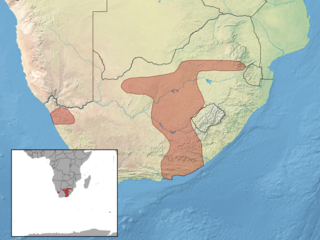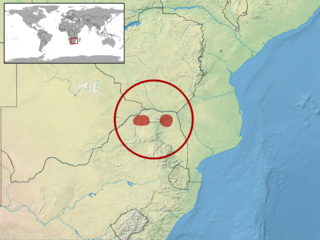Acontias is a genus of limbless skinks, the lance skinks, in the African subfamily Acontinae. Most are small animals, but the largest member of the genus is Acontias plumbeus at approximately 40 cm (16 in) snout-vent length. All members of this genus are live-bearing sandswimmers, with fused eyelids. A recent review moved species that were formerly placed in the genera Typhlosaurus, Acontophiops, and Microacontias into this genus, as together these form a single branch in the tree of life. This new concept of Acontias is a sister lineage to Typhlosaurus, and these two genera are the only genera within the subfamily Acontinae.
Scolecoseps is a genus of skinks, lizards in the family Scincidae. The genus is endemic to East Africa.

Typhlosaurus is a genus of African lizards, one of a number of genera of limbless lizards in the skink family (Scincidae). This group was recently revised with most species formerly attributed to Typhlosaurus now placed in Acontias. The current definition of Typhlosaurus includes five attenuate body legless lizards from southwestern Africa. This is the sister genus to Acontias, which together form the well supported Afrotropical subfamily Acontinae.

George Albert Boulenger was a Belgian-British zoologist who described and gave scientific names to over 2,000 new animal species, chiefly fish, reptiles, and amphibians. Boulenger was also an active botanist during the last 30 years of his life, especially in the study of roses.

The leopard tortoise is a large and attractively marked tortoise found in the savannas of eastern and southern Africa, from Sudan to the southern Cape. It is the only member of the genus Stigmochelys, although in the past, it was commonly placed in Geochelone. This tortoise is a grazing species that favors semiarid, thorny to grassland habitats. In both very hot and very cold weather, it may dwell in abandoned fox, jackal, or aardvark holes. The leopard tortoise does not dig other than to make nests in which to lay eggs. Given its propensity for grassland habitats, it grazes extensively upon mixed grasses. It also favors succulents and thistles.

Acontias breviceps, the shorthead lance skink or shortheaded legless skink, is a species of viviparous, legless, fossorial lizards occurring along the southern and eastern sections of the Great Escarpment in South Africa. It may grow up to 10 cm long.
The woodbush legless skink is a species of legless skink. It is found in the Wolkberg mountains of Limpopo Province, South Africa. Females of the species give birth to live young. This lizard species was formerly placed in a monotypic genus as Acontophiops lineatus. Morphologically the genus shows similarities to Acontias cregoi and a recent review placed both of these within the genus Acontias, which, as Acontias lineatus was already occupied, required a new name for this species.

Acontias gracilicauda, the slendertail lance skink or thin-tailed legless skink, is a species of skink. It is found in the Republic of South Africa and Lesotho. Acontias namaquensis was formerly included in this species as a subspecies, but is now recognized as a distinct species.
Proscelotes arnoldi, also known commonly as Arnold's skink or Arnold's montane skink, is a species of lizard in the family Scincidae. The species is endemic to Africa. Sometimes called a legless skink, it has tiny reduced limbs. The front limbs are very small, and both fore-limbs and hind-limbs have reduced function and appear to be vestigial attachments for its lifestyle and habitat.
Acontias albigularis, the white-throated legless skink, is a species of lizard in the family Scincidae. It is endemic to South Africa.
Acontias aurantiacus, the golden blind legless skink, is a species of lizard in the family Scincidae. It is found in Zimbabwe, Mozambique, Botswana, and South Africa.
Acontias cregoi, Cregoe's legless skink, is a species of lizard in the family Scincidae. It is endemic to South Africa.
Acontias fitzsimonsi, Fitzsimons' legless skink or Fitzsimon's legless skink, is a species of lizard in the family Scincidae. It is endemic to South Africa.
Acontias namaquensis, the Namaqua legless skink or Namaqua lance skink, is a species of lizard in the family Scincidae. It is endemic to Little Namaqualand, Northern Cape, South Africa.

Acontias plumbeus, the giant legless skink or giant lance skink, is a species of lizard in the family Scincidae. It is found in South Africa, Eswatini, Mozambique, and Zimbabwe.

Acontias richardi, Richard's legless skink, is a species of lizard in the family Scincidae. It is endemic to South Africa.
Haacke's legless skink, also known commonly as Brain's legless skink and Brain's blind legless skink, is a species of lizard in the family Scincidae. The species is endemic to Namibia.
Scolecoseps acontias, also known commonly as the sandy limbless skink, is a species of lizard in the family Scincidae. The species is endemic to Tanzania.









